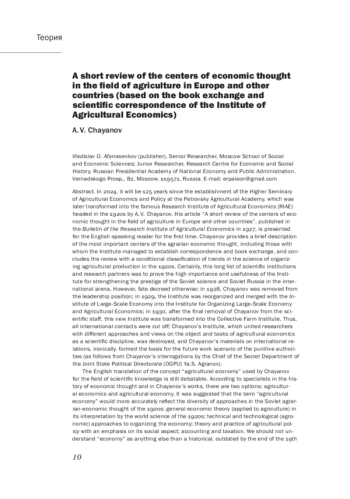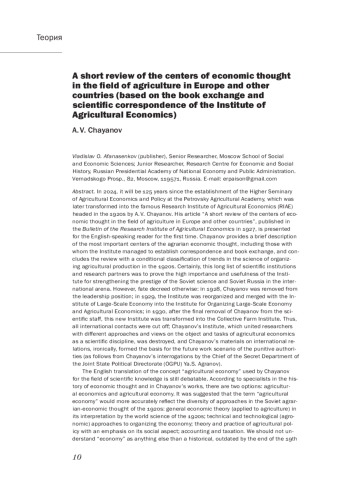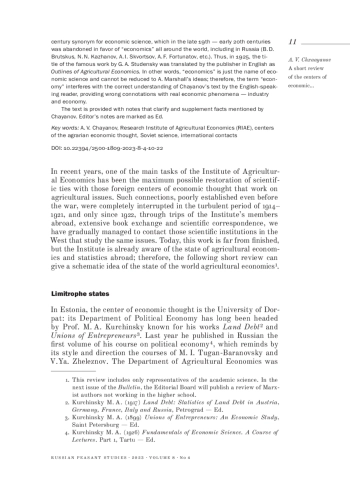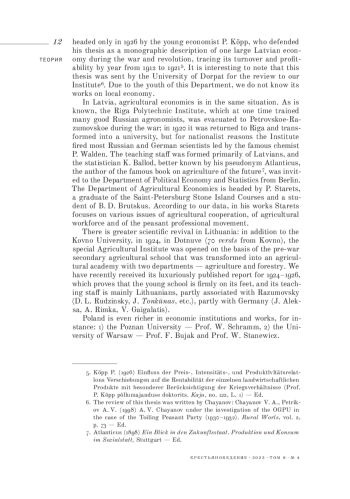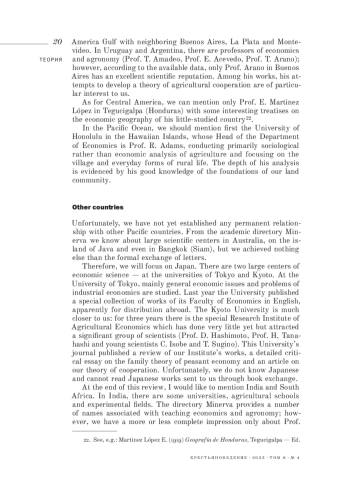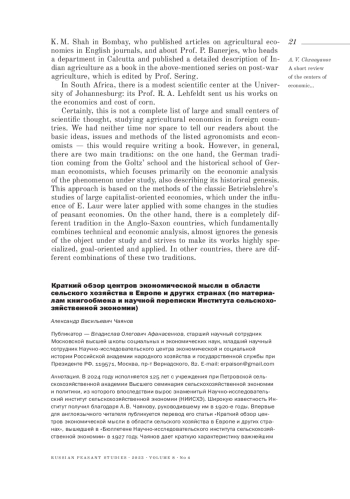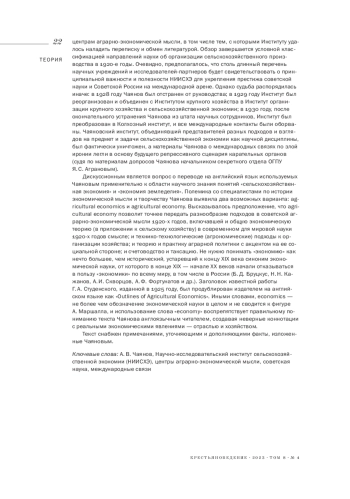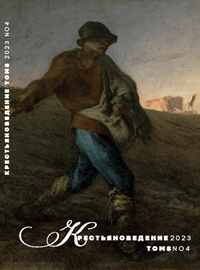В 2024 году исполняется 125 лет с учреждения при Петровской сельскохозяйственной академии Высшего семинария сельскохозяйственной экономии и политики, из которого впоследствии вырос знаменитый Научно-исследовательский институт сельскохозяйственной экономии (НИИСХЭ). Широкую известность Институт получил благодаря А. В. Чаянову, руководившему им в 1920-е годы. Впервые для англоязычного читателя публикуется перевод его статьи «Краткий обзор центров экономической мысли в области сельского хозяйства в Европе и других странах», вышедшей в «Бюллетене Научно-исследовательского института сельскохозяйственной экономии» в 1927 году. Чаянов дает краткую характеристику важнейшим центрам аграрно-экономической мысли, в том числе тем, с которыми Институту удалось наладить переписку и обмен литературой. Обзор завершается условной классификацией направлений науки об организации сельскохозяйственного производства в 1920-е годы. Очевидно, предполагалось, что столь длинный перечень научных учреждений и исследователей-партнеров будет свидетельствовать о принципиальной важности и полезности НИИСХЭ для укрепления престижа советской науки и Советской России на международной арене. Однако судьба распорядилась иначе: в 1928 году Чаянов был отстранен от руководства; в 1929 году Институт был реорганизован и объединен с Институтом крупного хозяйства в Институт организации крупного хозяйства и сельскохозяйственной экономии; в 1930 году, после окончательного устранения Чаянова из штата научных сотрудников, Институт был преобразован в Колхозный институт, и все международные контакты были оборваны. Чаяновский институт, объединявший представителей разных подходов и взглядов на предмет и задачи сельскохозяйственной экономии как научной дисциплины, был фактически уничтожен, а материалы Чаянова о международных связях по злой иронии легли в основу будущего репрессивного сценария карательных органов (судя по материалам допросов Чаянова начальником секретного отдела ОГПУ Я. С. Аграновым). Дискуссионным является вопрос о переводе на английский язык используемых Чаяновым применительно к области научного знания понятий «сельскохозяйственная экономия» и «экономия земледелия». Полемика со специалистами по истории экономической мысли и творчеству Чаянова выявила два возможных варианта: agricultural economics и agricultural economy. Высказывалось предположение, что agricultural economy позволит точнее передать разнообразие подходов в советской аграрно-экономической мысли 1920-х годов, включавшей и общую экономическую теорию (в приложении к сельскому хозяйству) в современном для мировой науки 1920-х годов смысле; и технико-технологические (агрономические) подходы к организации хозяйства; и теорию и практику аграрной политики с акцентом на ее социальной стороне; и счетоводство и таксацию. Не нужно понимать «экономию» как нечто большее, чем исторический, устаревший к концу XIX века синоним экономической науки, от которого в конце XIX - начале XX веков начали отказываться в пользу «экономики» по всему миру, в том числе в России (Б. Д. Бруцкус, Н. Н. Кажанов, А. И. Скворцов, А. Ф. Фортунатов и др.). Заголовок известной работы Г. А. Студенского, изданной в 1925 году, был продублирован издателем на английском языке как «Outlines of Agricultural Economics». Иными словами, еconomics - не более чем обозначение экономической науки в целом и не сводится к фигуре А. Маршалла, и использование слова «economy» воспрепятствует правильному пониманию текста Чаянова англоязычным читателем, создавая неверные коннотации с реальными экономическими явлениями - отраслью и хозяйством. Текст снабжен примечаниями, уточняющими и дополняющими факты, изложенные Чаяновым.
In 2024, it will be 125 years since the establishment of the Higher Seminary of Agricultural Economics and Policy at the Petrovsky Agricultural Academy, which was later transformed into the famous Research Institute of Agricultural Economics (RIAE) headed in the 1920s by A. V. Chayanov. His article “A short review of the centers of economic thought in the field of agriculture in Europe and other countries”, published in the Bulletin of the Research Institute of Agricultural Economics in 1927, is presented for the English-speaking reader for the first time. Chayanov provides a brief description of the most important centers of the agrarian economic thought, including those with whom the Institute managed to establish correspondence and book exchange, and concludes the review with a conditional classification of trends in the science of organizing agricultural production in the 1920s. Certainly, this long list of scientific institutions and research partners was to prove the high importance and usefulness of the Institute for strengthening the prestige of the Soviet science and Soviet Russia in the international arena. However, fate decreed otherwise: in 1928, Chayanov was removed from the leadership position; in 1929, the Institute was reorganized and merged with the Institute of Large-Scale Economy into the Institute for Organizing Large-Scale Economy and Agricultural Economics; in 1930, after the final removal of Chayanov from the scientific staff, this new Institute was transformed into the Collective Farm Institute. Thus, all international contacts were cut off; Chayanov’s Institute, which united researchers with different approaches and views on the object and tasks of agricultural economics as a scientific discipline, was destroyed, and Chayanov’s materials on international relations, ironically, formed the basis for the future work scenario of the punitive authorities (as follows from Chayanov’s interrogations by the Chief of the Secret Department of the Joint State Political Directorate (OGPU) Ya. S. Agranov). The English translation of the concept “agricultural economy” used by Chayanov for the field of scientific knowledge is still debatable. According to specialists in the history of economic thought and in Chayanov’s works, there are two options: agricultural economics and agricultural economy. It was suggested that the term “agricultural economy” would more accurately reflect the diversity of approaches in the Soviet agrarian-economic thought of the 1920s: general economic theory (applied to agriculture) in its interpretation by the world science of the 1920s; technical and technological (agronomic) approaches to organizing the economy; theory and practice of agricultural policy with an emphasis on its social aspect; accounting and taxation. We should not understand “economy” as anything else than a historical, outdated by the end of the 19th century synonym for economic science, which in the late 19th - early 20th centuries was abandoned in favor of “economics” all around the world, including in Russia (B. D. Brutskus, N. N. Kazhanov, A. I. Skvortsov, A. F. Fortunatov, etc.). Thus, in 1925, the title of the famous work by G. A. Studensky was translated by the publisher in English as Outlines of Agricultural Economics. In other words, “economics” is just the name of economic science and cannot be reduced to A. Marshall’s ideas; therefore, the term “economy” interferes with the correct understanding of Chayanov’s text by the English-speaking reader, providing wrong connotations with real economic phenomena - industry and economy. The text is provided with notes that clarify and supplement facts mentioned by Chayanov. Editor’s notes are marked as Ed.
Предпросмотр статьи
Идентификаторы и классификаторы
- SCI
- Образование
